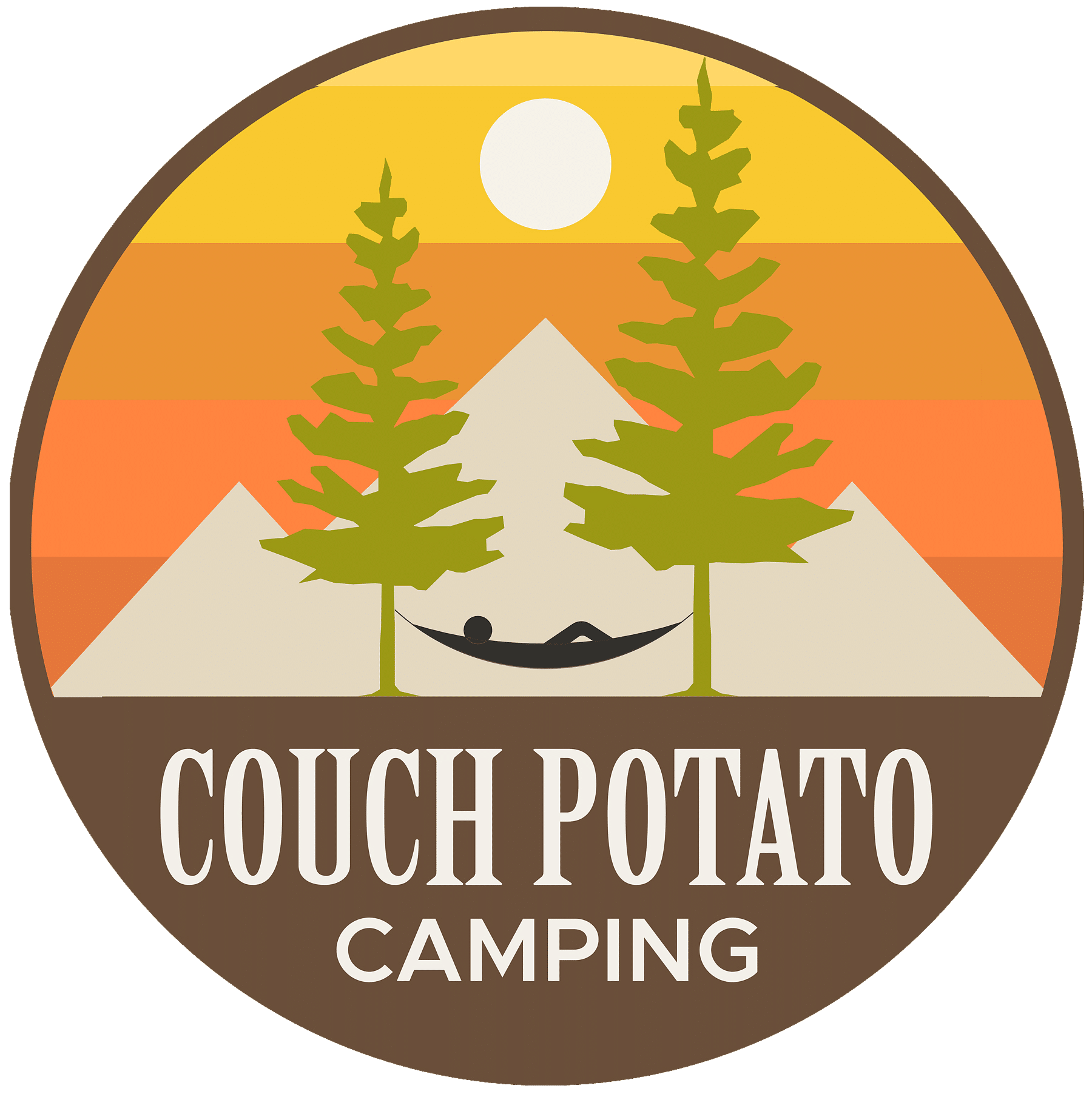There are over 60 national parks located in the USA and its territories, visitors have a variety of unique natural wonders and diverse landscapes to explore. Whether you enjoy snow-covered mountainous terrain or the stark beauty of the dessert, each park offers something special for those who want to camp or RV in the parks.
Visitors to the national parks are given access to some of the most incredible pristine natural landscapes and wonders in the United States. With a combined area of over 50 million acres, the 63 national parks within the National Park Service system there is plenty of open space to explore for RVers, campers, and the adventurous types.
While it was not easy, we’ve managed to narrow down the sixteen best campgrounds in the US National Parks. These national parks and campgrounds have been carefully selected based on their ability to immerse campers and RVers into the natural wonders of the parks.

16. Acadia National Park
Located in the state of Maine, Acadia National Park is nearly 50,000 acres in size. One of its most popular features and visited locations is Cadillac Mountain, the tallest mountain on the Atlantic coast of the United States. Many visitors and campers wake up prior early in the morning and hike to the top of Cadillac Mountain to see the first sunrise visible from the mainland US.

Things To See in Acadia National Park
During the Summer months, recreation options within the park include hiking, horseback riding, rock climbing, and swimming at in the ocean at Sand Beach or the beach at the freshwater Echo. Winter activities within the park includes trail hiking – snowshoes recommended, snowmobiling, cross-country skiing, and ice fishing on the parks lakes and ponds.
The beauty of Acadia is its diverse geography ranging mountains and the Atlantic, to lakes, ponds, and pine forests. The park’s 27-mile park loop road is open seasonally, weather depending, from April 1st through December 1st each year. From the loop road, many of the park’s scenic vistas and trails are easily accessible.
Campgrounds in Acadia National Park
Acadia National Park offers five campgrounds within the park:
- Seawall Campground
- Blackwoods Campground
- Schoodic Woods Campground
- Duck Harbor Campground
- Wildwood Stables Campground
Our suggested campground in Acadia is Blackwoods Campground. Blackwoods Campground is approximately five miles from the town of Bar Harbor. Blackwoods offers 60 RV-only sites and 221 tent-only campsites. There are no sites with electrical hookups, however, all 281 campsites are a 10-minute walk from the ocean.
Blackwoods over amenities such as flush toilets, a dump station for RVs, potable water, fire rings and grills, a seasonal amphitheater and staff is on site for questions, etc.
A few things to know about camping in Acadia National Park:
- No backcountry camping is permitted.
- All Acadia campgrounds are seasonal – End of May through early October
- No winter camping or overnight parking is allowed anywhere.
- All campsites require a reservation – available 2 months in advance
- Do not bring your own firewood if greater than 50 miles away. Local firewood is available.
- Accessibility via vehicles varies campground-to-campground.
15. Arches National Park
Located on the outskirts of Moab, Utah, Arches National Park offers visitors the iconic and delicate sandstone arch features making it one of the most unique and beautiful national parks. There are officially more than 2,000 arches contained within this 76,000-plus acre park created over millions of years of wind and water erosion.
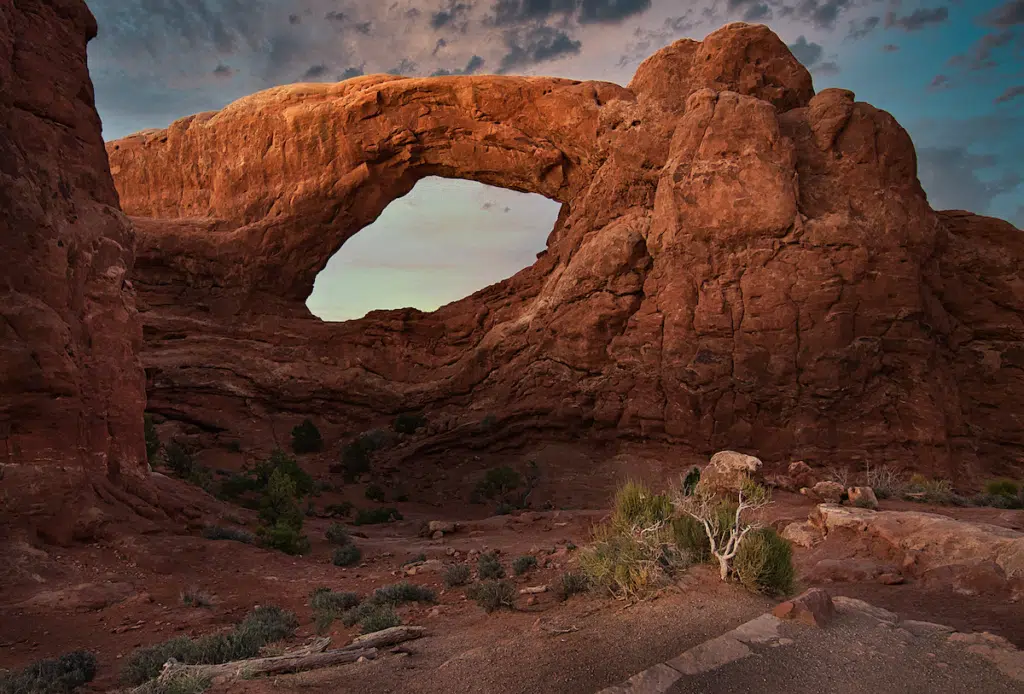
Things To See in Arches National Park
We do not suggest visiting Arches during the summer months since being located in the desert its temperatures can sour over 100 degrees Fahrenheit. Also, due to the popularity of this national park, we suggest arriving early since on heavily attended days – during the shoulder season months – the park gates will be closed by the National Park Service once the park reaches its maximum attendance levels for that day.
We suggest hiking to Delicate Arch, Double Arch, and Landscape Arch. Also, you don’t want to miss Balanced Rock accessible via a short walk off the main road, Courthouse Towers, Devil’s Garden, the Fiery Furnace area of narrow passageways and the Petrified Dunes – all accessible from the park’s Main Park Road and its subsequent side roads: Windows Road and Delicate Arch Road. Be mindful, there are several unpaved roads within the park, but many require a high-clearance vehicle to access and they may be closed during seasons and months of inclement weather.
Camping in Arches National Park
Contained within the boundaries of Arches National Park, towards the back portion of the park and approximately 18 miles from the main entrance, is the Devils Garden Campground. Some of the features of this campground are:
- Open year round (March 1st through October 31st reservations are recommended)
- Has 51 sites available
- November through the end of February, the campground is first-come, first-served.
- No electrical hookups
- No on-site camp store at the campground
- No dump station
- No showers
- No potable water
- No cell service or WiFi available
- Fire rings provided
- Firewood available at the Visitor Center’s bookstore
- Local firewood collection is not permitted in the park
- Flush and vault toilets provided year round
✅ Looking for a full service campground near Arches National Park and Canyonlands National Park? Check out Sun Outdoors Canyonlands Gateway (formerly named Archview RV Resort and Campground):
14. Badlands National Park
The desert landscape containing buttes, fossil beds, pinnacles, grassy prairies, bison, bighorn sheep, and prairie dogs are all found in Badlands National Park located in South Dakota, roughly 75 miles east of Rapid City. Spanning approximately 240,000 acres in size, Badlands National Park is one of the more unique in the park service’s roster.
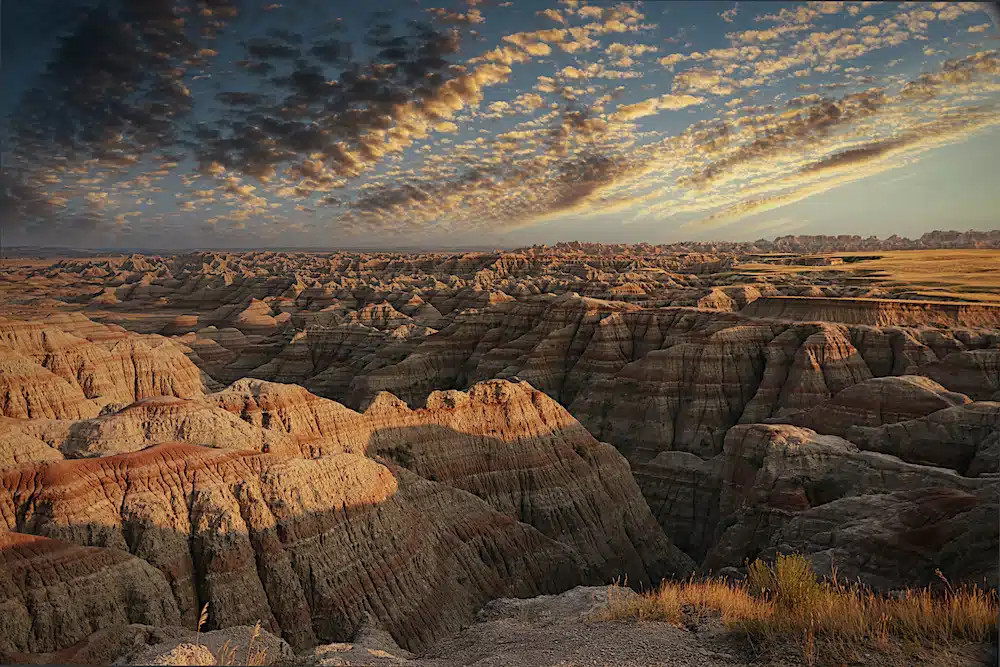
Things To See in Badlands National Park
Locations such as the Pinnacles area, the Ancient Hunters viewpoint, and the Seabed Jungle Overlook all accessible via the park’s several loop roads. While visiting Badlands National Park, be sure to visit the Ben Reifel Visitor Center to speak with Rangers, visit the bookstore, see a short film about the park, and grab some lunch at the adjacent Cedar Pass Lodge (open seasonally April through October).
Camping in Badlands National Park
There are two campground options within Badlands National park:
The Cedar Pass Campground is a paid campground taking reservations for their 96 camping sites, some allocated with electrical hookups for RVs. Other features include:
- Charcoal grills and camp stoves are permitted in picnic areas
- Cedar Pass is open year-round, stays are limited to 14 days
- Fires are not permitted in the campground
- No wood collection is permitted at either campground
The park also has the first-come, first-served Sage Creek Campground. Sage Creek has 22 sites an 18′ length limitation for RV’s and vehicles. Here are some of the amenities and things to keep in mind about these campgrounds:
- Charcoal grills and camp stoves are permitted in picnic areas
- Roads may be impassable during and after inclement weather
- A portion of the campground is designated for horse use
- Pit toilets are provided, but no potable water available
- There is no trailer length limitation for horse trailers
- No wood collection is permitted at either campground
✅ Planning on boon docking in a National Park campground?
Check out our portable generator guide!
13. Joshua Tree National Park
Joshua Tree National Park is renowned for its unique desert landscape, rugged rock formations, and the eponymous Joshua Trees that dot the area. The park, roughly 790,636 acres in size, is located at the intersection of two distinct desert ecosystems: the Mojave and the Colorado, giving its diverse range of flora and fauna. Visitors to the park can expect to encounter a variety of wildlife, including bighorn sheep, coyotes, rattlesnakes, and various species of birds.

Things To See in Joshua Tree National Park
Within Joshua Tree National Park, visitors have access to a wide range of attractions and activities. Though a desert landscape, the natural diversity contained within the park is worth exploring. Recreation actives include hiking, bird watching, excellent photography locations, rock climbing, backpacking, biking, horseback riding, and one of our favorites is stargazing in the dark skies above the park. One of the most popular areas to explore include Hidden Valley, a secluded area surrounded by towering rock formations. The park as several great hiking trails, including the Lost Palms Oasis trail and the Ryan Mountain trail – for those looking for a more challenging hike.
Campgrounds in Joshua Tree National Park
There are nine campgrounds within the park, offering visitors 500 campsites to choose from. Given its desert location, campsites are extremely popular on weekends from October through May. Hidden Valley Campground is our favorite campground within the park. Hidden Valley offers 44 sites for both campers and visitors with RVs. The scenic beauty of this campground is incredible as you literally camp amidst the large boulders and Joshua Trees. Some Hidden Valley’s features include:
- Open year round
- Designated picnic areas with shelters, fire rings and grills
- Bring your own firewood
- Wood collection within the park is not permitted
- Pit toilets provided
- No showers
- No electrical hookups
- No potable water
12. Death Valley National Park
Covering over 3.4 million acres of desert wilderness, Death Valley National Park is located in eastern California. It’s the largest national park in the lower 48 US states, and one of the hottest and driest places on the planet and the lowest point in the US. The park’s extreme summer temperatures can exceed 120 degrees Fahrenheit, but it boasts a beautiful desert landscape featuring mountains, colorful sand dunes, canyons, and salt flats.

Things To See in Death Valley National Park
One of the most popular attractions in Death Valley National Park is Badwater Basin, the lowest point in North America at 282 feet below sea level. Another must-see location in the park is Zabriskie Point, which offers breathtaking views of the colorful badlands and eroded rock formations. For those looking for a more challenging adventure, the park offers backcountry camping and hiking opportunities, including the famous 134-mile-long Death Valley Trail. Historic sites within the park include the abandoned mining town of Rhyolite and visitors can take guided tours of Scotty’s Castle, a mansion built in the 1920s.
Camping in Death Valley National Park
The park has nine campgrounds, with some offering RV hookups and others providing tent camping. Furnace Creek Campground is the most popular campground, located near the park’s visitor center and offering 136 sites. Reservations for camping sites are available up to 6 months in advance between mid-October through mid-April, the remainder of the year is first-come, first-served. Some of the campground’s features include:
- Open year-round
- Dump station provided
- Potable water accessible
- 18 Sites have electrical hookup
- 45 Tent only sites
- 5 Group sites
- Cell phone service available
- No internet or WiFi avilable
- Camp store open year-round
- No firewood is available
- Reservations recommended
11. Denali National Park and Preserve
Denali National Park and Preserve is one of the most popular national parks in the United States, located in Alaska’s Interior region. Covering an area of 6 million acres, the park offers visitors a chance to experience the breathtaking beauty of Alaska’s wilderness, including glaciers, mountains, forests, and tundra. The park’s centerpiece is the Denali mountain, the tallest peak in North America, rising 20,310 feet above sea level. The park is also home to a diverse array of wildlife, including grizzly bears, moose, wolves, and caribou, making it a popular destination for wildlife enthusiasts.

Visitors to Denali National Park can explore the park’s vast wilderness through a variety of activities, including hiking, camping, and wildlife viewing. The park offers over 350 miles of hiking trails, ranging from easy walks to challenging multi-day backpacking trips. The park’s wildlife is another popular attraction, and visitors can take guided tours or explore on their own in search of bears, moose, wolves, and other animals. Other popular activities include birdwatching, fishing, and mountaineering.
Things To See in Denali National Park
Denali National Park is home to several popular locations that visitors can explore, including the Denali Visitor Center, which offers exhibits and information about the park’s history, wildlife, and geology. The park also has several campgrounds, including the Savage River Campground, which is open year-round and offers stunning views of the surrounding mountains. Other popular locations include the Polychrome Overlook, which offers panoramic views of the park’s stunning landscape, and Wonder Lake, which is known for its picturesque reflections of the Denali mountain.
Campgrounds in Denali National Park
The park features several campgrounds, ranging from primitive sites with no amenities to sites with electricity and water hookups. For those who prefer more comfortable lodging, there are also several backcountry lodges in the park and hotels located just outside the park. Visitors should note that reservations are strongly recommended for all overnight stays in Denali National Park, especially during peak season from mid-June to early September.
10. Dry Tortugas National Park
Dry Tortugas National Park is a protected area located in the Gulf of Mexico, about 68 miles west of Key West, Florida. It covers a total area of approximately 100 square miles, which includes seven small islands and the surrounding waters. The park is best known for its crystal-clear blue waters, coral reefs, and historical significance. One of the park’s most prominent features is the 19th-century fortress, Fort Jefferson, which was built to protect the United States from enemy attacks. The park is also home to diverse marine life, including sea turtles, dolphins, and hundreds of species of fish.
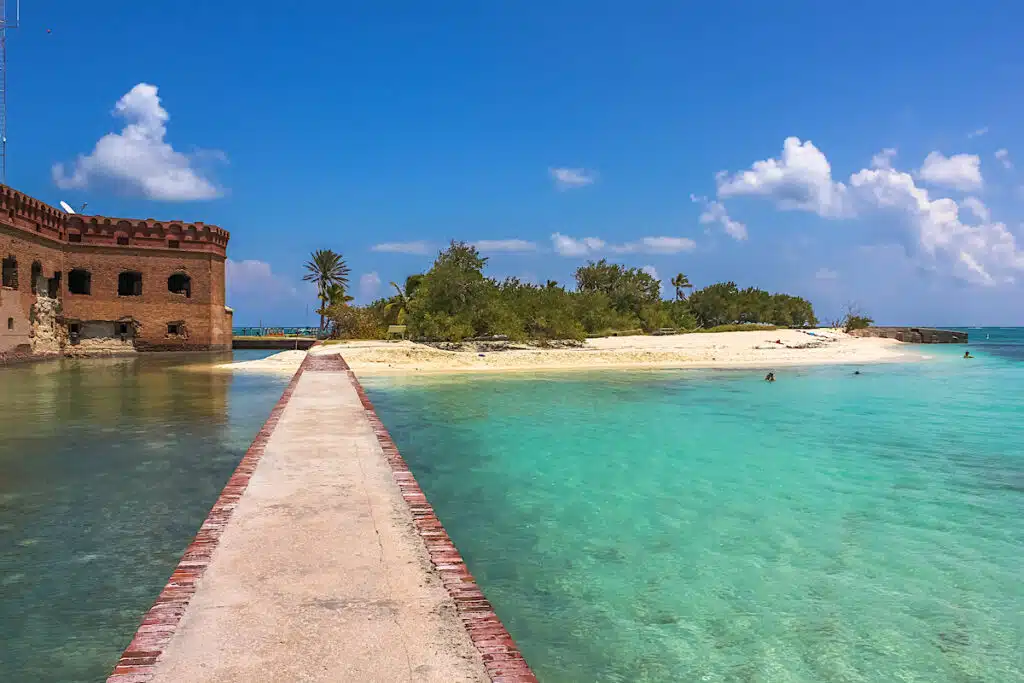
Visitors to Dry Tortugas National Park can enjoy a variety of outdoor activities, including snorkeling, scuba diving, fishing, and birdwatching. The park’s coral reefs are some of the most pristine in the world, making it a popular destination for snorkelers and divers. The park also offers guided tours of Fort Jefferson, where visitors can learn about the history of the fort and its role in protecting the United States. In addition, visitors can hike along the park’s nature trails, which offer stunning views of the islands and the surrounding waters.
Things To See in Dry Tortugas National Park
Some of the most popular locations within Dry Tortugas National Park include Garden Key, Loggerhead Key, and Bush Key. Garden Key is home to Fort Jefferson, the park’s main attraction, as well as a campground, picnic areas, and a lighthouse. Loggerhead Key is the second-largest island in the park and is home to a historic lighthouse that offers panoramic views of the park. Bush Key, on the other hand, is a small island that is closed to the public during the nesting season of the sooty tern, a type of bird that nests on the island.
Camping in Dry Tortugas National Park
Camping options in the park are limited to the Garden Key Campground, which is accessible only by boat or seaplane. The campground offers 10 primitive campsites with stunning ocean views and easy access to snorkeling, kayaking, and other outdoor activities. Visitors should come prepared with all necessary supplies, as there are no stores or facilities on the island. Other camping considerations include:
- Reservations not available for the 6-person campsites
- Individual sites can accommodate (3) 2-person tents
- Overflow camping area is available if tent sites are taken
- Sites include picnic tables, grills, and elevated hooks
- No public showers available
- All supplies and garbage must be taken away by campers
9. Everglades National Park
Everglades National Park is one of the largest national parks in the United States, covering 1.5 million acres in the southernmost part of Florida. The park is home to a diverse array of wildlife, including endangered species such as the Florida panther, the manatee, and the American crocodile. It is also known for its unique ecosystem, which includes both freshwater and saltwater habitats, making it one of the most biologically diverse areas in the country.
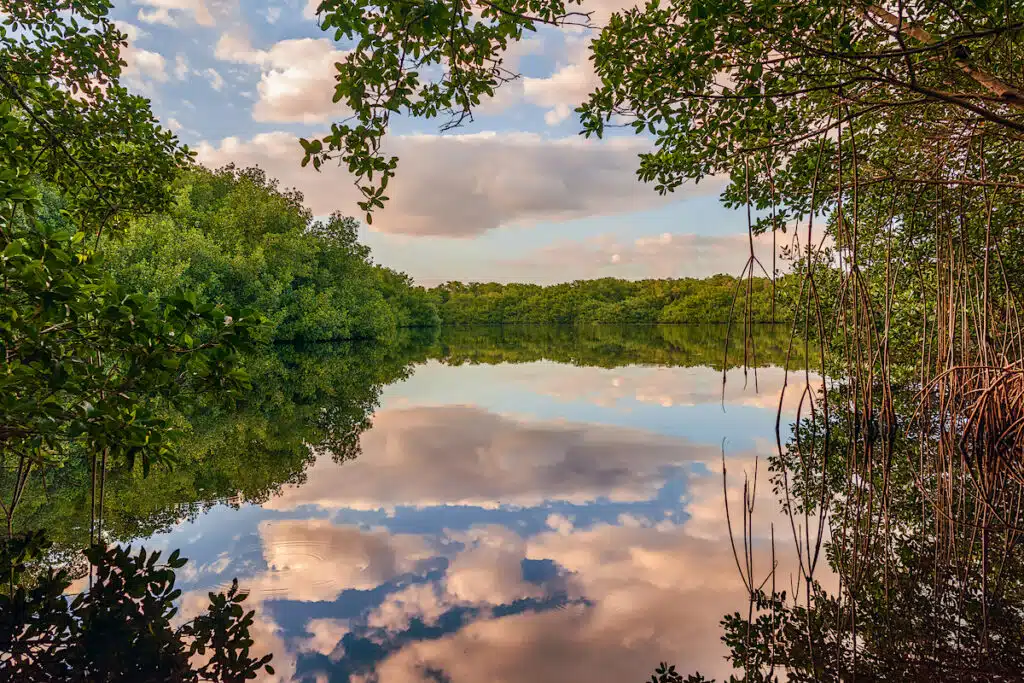
One of the most popular features of Everglades National Park is the vast network of waterways that flow throughout the park. Visitors can explore the park’s waterways by canoe, kayak, or boat, and may even spot alligators, turtles, and other wildlife along the way. The park is also home to a number of hiking trails, including the Anhinga Trail, which takes visitors through a marsh filled with alligators and other aquatic wildlife.
Things To See in Everglades National Park
In addition to its natural wonders, Everglades National Park is also home to a rich cultural history. The park is home to the Miccosukee and Seminole tribes, and visitors can learn about their traditions and customs at various sites throughout the park. Other popular locations within the park include Shark Valley, which offers stunning views of the park’s sawgrass prairies, and Flamingo, which is known for its world-class fishing opportunities.
Campgrounds in Everglades National Park
There are two drive-in campgrounds available: Long Pine Key Campground and Flamingo Campground, both with amenities such as picnic tables and fire rings. Additionally, backcountry camping permits are available for visitors looking to explore more remote areas of the park. Notable campground features include:
- Cell phone service is available (stronger in some locations)
- No laundry facilities
- Camp supplies available year-round
- No food storage lockers provided
- Fires permitted in grills only
- Showers and restrooms available year-round
- No internet connectivity provided
- 41 sites with electric hook-ups (Flamingo Campground)
8. Glacier National Park
Glacier National Park, located in Montana, is one of the United States’ most stunning national parks, covering over 1 million acres. The park is named for the numerous glaciers that once covered its mountains, and its beauty is attributed to the diverse array of natural features that can be found within it. The park is home to more than 700 miles of hiking trails, with a range of difficulty levels to cater to hikers of all skill levels.
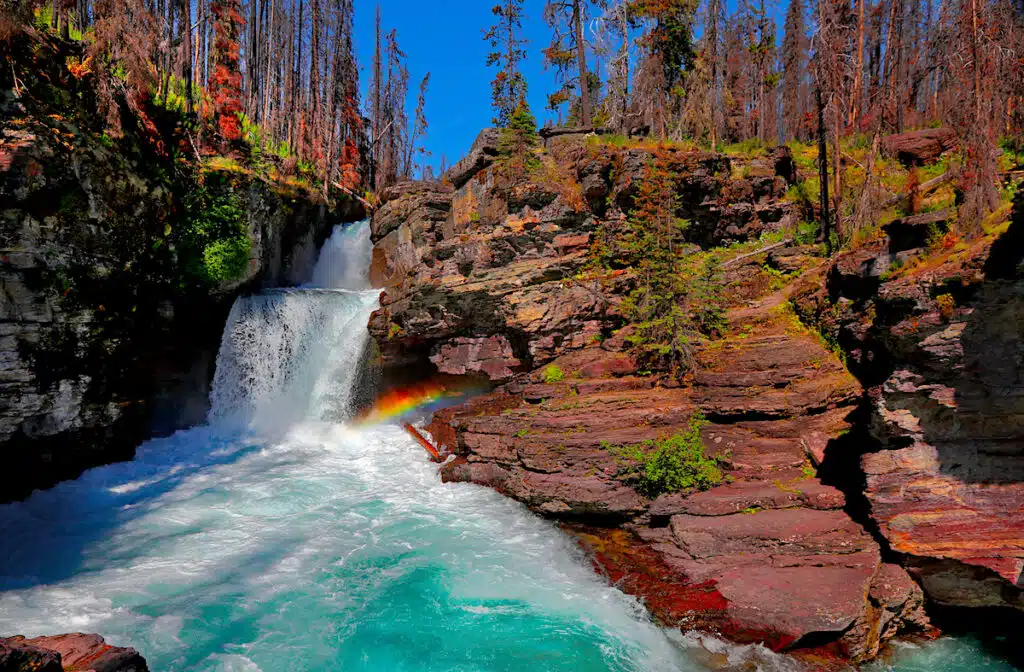
Glacier National Park boasts numerous stunning natural features, including 26 glaciers, more than 130 named lakes, and an array of alpine meadows, forests, and waterfalls. The park is home to the Going-to-the-Sun Road, a scenic drive that spans 50 miles and offers breathtaking views of the park’s peaks and valleys. Along the route, visitors can stop at numerous pullouts and overlooks to take in the scenery or hike to nearby attractions, such as Logan Pass or Hidden Lake.
Things To See in Glacier National Park
Visitors to Glacier National Park can explore its varied landscapes in numerous ways, including hiking, camping, fishing, and wildlife watching. Some of the most popular destinations within the park include Lake McDonald, the largest lake in the park, and Many Glacier, an area known for its stunning alpine vistas and abundant wildlife.
Campgrounds in Glacier National Park
There are 13 campgrounds available, with different amenities and levels of accessibility, making it easy for visitors to find the perfect spot to pitch a tent or park an RV. The park also has several lodges, including the iconic Many Glacier Hotel, which was built in 1915 and features stunning views of the mountains and lakes. Here are some tips and features about Glacier’s campgrounds:
- Reservations suggested for: Apgar, Fish Creek, Sprague Creek, Avalanche, St. Mary, Many Glacier, and Two Medicine Campgrounds
- Several remote campgrounds are first-come, first-served
- There are a limited number of camp sites for cyclists or those arriving on foot
- Quite hours: 10 pm to 6 am
- Generator use hours: 8 am–10 am, noon–2 pm, or 5 pm–7 pm
- Firewood available for purchase. Gathering limited to specific areas.
7. Grand Canyon National Park
Grand Canyon National Park, located in northwestern Arizona, is a UNESCO World Heritage Site known for its iconic vistas and stunning natural beauty. The park covers over 1.2 million acres, making it one of the largest national parks in the United States. The canyon itself is approximately 277 miles long, up to 18 miles wide, and over a mile deep, carved over millions of years by the Colorado River.
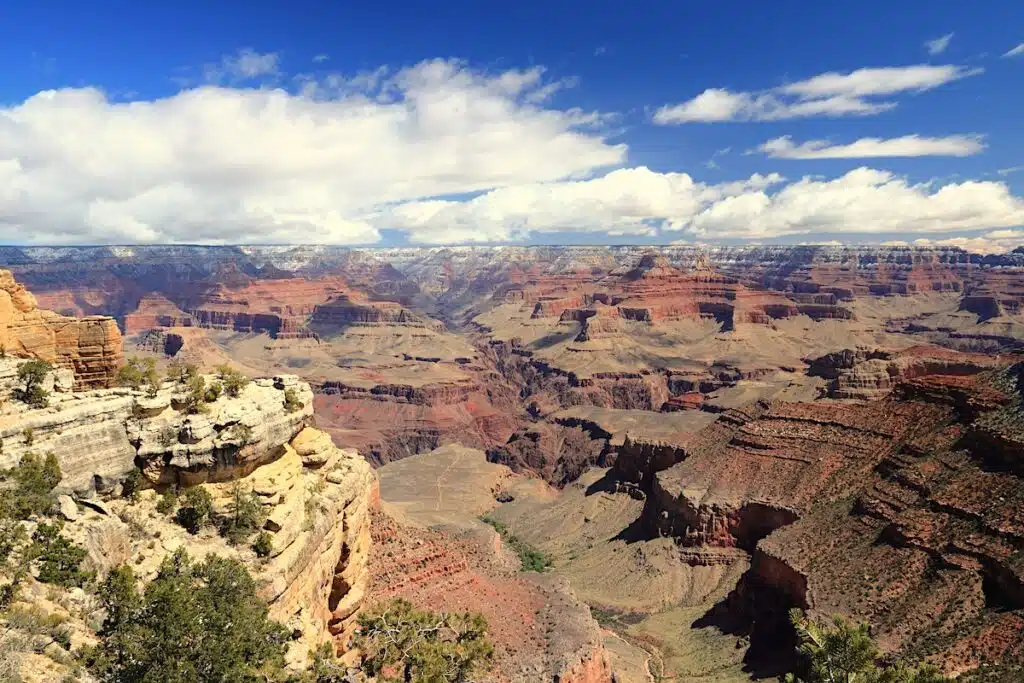
One of the main attractions at Grand Canyon National Park is, of course, the canyon itself. Visitors can enjoy stunning views of the canyon from various vantage points, including the popular South Rim and the less-crowded North Rim. The park also offers a range of activities, such as hiking, backpacking, and rafting, allowing visitors to explore the canyon’s diverse landscapes up close. Additionally, the park is home to a variety of wildlife, including California condors, bighorn sheep, and mountain lions.
Things To See in Grand Canyon National Park
Within the park, there are several popular locations for visitors to explore. The South Rim, located on the southern side of the canyon, is the most visited area of the park and offers a range of amenities, including hotels, restaurants, and gift shops. The North Rim, located on the northern side of the canyon, is more remote and less crowded, offering visitors a quieter and more secluded experience. Other notable locations within the park include the Grand Canyon Village, which offers historic buildings and museums, and the Havasu Falls, a series of stunning waterfalls located in the western part of the park.
Campgrounds in Grand Canyon National Park
Grand Canyon National Park offers a variety of lodging options, including campgrounds, lodges, and hotels. The South Rim, which is the most popular area of the park, has several lodges and hotels, including El Tovar, Bright Angel Lodge, and Maswik Lodge, all of which are operated by Xanterra Travel Collection. In addition to these options, there are also several campgrounds located on the South Rim, including Mather Campground, Trailer Village, and Desert View Campground. The North Rim, which is less developed and visited, has one lodge, the Grand Canyon Lodge, operated by Forever Resorts. Other amenities include:
- Open year-round
- Dump stations provided
- Potable water accessible
- Circular/pull through sites available
- Tent camping permitted
- Group sites available
- No internet or WiFi avilable
- Camp store open year-round
- Reservations recommended
6. Grand Teton National Park
Grand Teton National Park is a stunning natural wonder situated in northwestern Wyoming, USA. The park spans over 310,000 acres and boasts a diverse range of wildlife, lakes, and mountains. The most famous peak in the park, the Grand Teton, rises to a height of 13,775 feet and is a popular destination for hikers and climbers. In addition to its impressive geological formations, the park is also home to a wide variety of animals, including grizzly bears, moose, elk, and bald eagles.

Things To See in Grand Teton National Park
One of the most popular activities in Grand Teton National Park is hiking. Visitors can choose from over 200 miles of trails, ranging from easy nature walks to strenuous mountain climbs. The park also offers several scenic drives, including the Teton Park Road, which winds through the heart of the park and provides stunning views of the surrounding mountains and lakes. In the winter, the park is transformed into a winter wonderland, with opportunities for skiing, snowshoeing, and wildlife watching.
Grand Teton National Park is home to several must-visit locations, including the Jenny Lake Visitor Center, where visitors can learn about the park’s history and geology, and take a boat ride across the lake. Other popular spots include the Mormon Row Historic District, where visitors can see restored homesteads dating back to the late 1800s, and the Jackson Hole Wildlife Safaris, which offers guided tours of the park’s wildlife and landscapes.
Campgrounds in Grand Teton National Park
For those who prefer camping, there are several campgrounds located within the park, including the popular Jenny Lake and Colter Bay campgrounds. These campgrounds offer scenic views of the Teton Range and easy access to hiking trails and other outdoor activities. Campground amenities and features include:
- Campgrounds are reservation-only
- No overnight car camping is permitted in parking lots, turn outs, etc.
- Jenny Lake Campground is tents only, no RVs
- Campgrounds accommodating RVs have length limits – confirm when reserving
- Signal Mountain, Colter Bay, Headwaters Campgrounds have laundry facilities
- Firewood available for purchase (seasonal)
If you’re looking for a more luxurious option, the park also offers several lodges and hotels, including the historic Jackson Lake Lodge and the up-scale rustic cabins at Jenny Lake Lodge. These properties offer comfortable accommodations and a range of amenities, including restaurants, shops, and guided tours.
5. Great Smoky National Park
Great Smoky Mountains National Park is a popular destination in the United States that offers visitors breathtaking views, diverse wildlife, and a chance to experience the natural beauty of the region. Located in the southern Appalachian Mountains, the park is straddled between the states of Tennessee and North Carolina. With an area of over 816 square miles, it is the most visited national park in the United States, attracting more than 12 million visitors each year.
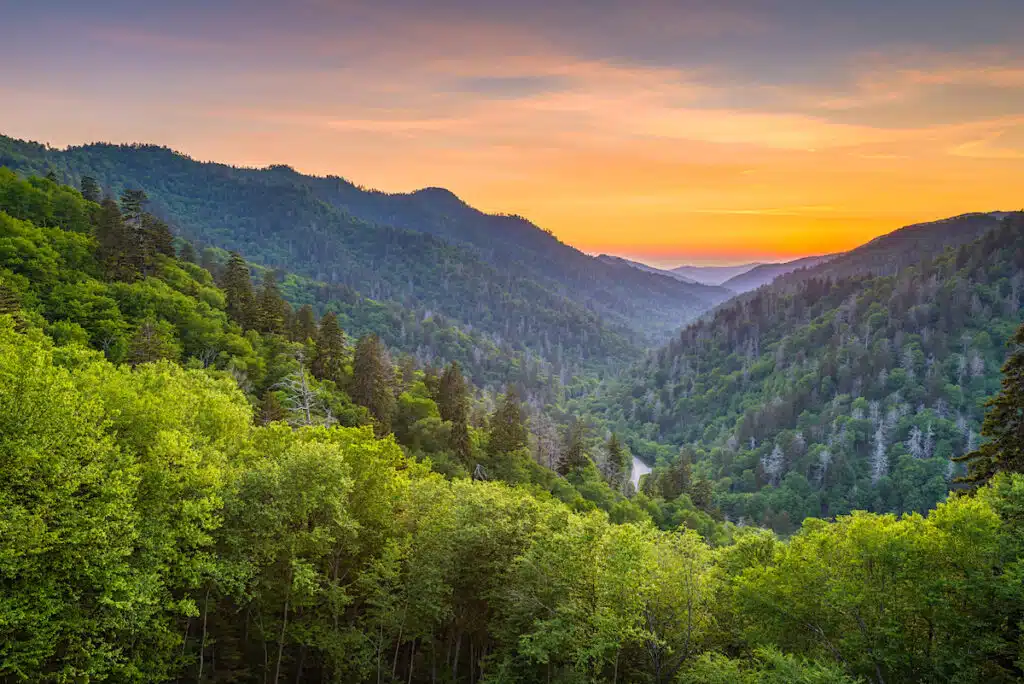
One of the main features of the Great Smoky Mountains National Park is its diverse ecosystem, which includes over 19,000 documented species of plants and animals. Visitors can enjoy hiking, fishing, camping, and picnicking in the park, with more than 800 miles of trails available. Among the park’s most popular attractions are Clingmans Dome, the highest point in the park, and Cades Cove, a historic valley with a variety of historic buildings and stunning scenery.
Things To See in Great Smoky National Park
There are numerous locations within the Great Smoky Mountains National Park that are worth exploring. Visitors can explore the Roaring Fork Motor Nature Trail, which offers scenic views of waterfalls, mountains, and historic buildings. The park is also home to several museums, including the Great Smoky Mountains Heritage Center and the Mountain Farm Museum. In addition, the park offers opportunities for outdoor adventures such as horseback riding, rafting, and zip-lining, making it a perfect destination for anyone seeking to immerse themselves in the great outdoors.
Campgrounds in Great Smoky National Park
Great Smoky Mountains National Park is home to a variety of accommodation options that provide visitors with a comfortable place to rest after a day exploring the park’s vast natural beauty. The park boasts ten developed campgrounds, offering both primitive and modern amenities. Most campgrounds have picnic tables, fire pits, and access to restrooms and showers. Camping considerations include:
- Only heat-treated firewood can be brought in (USDA certified only)
- Advanced reservations required at all campgrounds year-round
- Campfires permitted in fire grates only
- Camp sites are limited to 6 people
- No more than 2 vehicles (or vehicle plus RV) allowed for RV sites
- Pets allowed in campground-must be leashed
- Quite hours: 10 pm to 6 am
- Generator hours: prohibited 8 pm to 8 am
In addition to camping, visitors can stay in one of several lodges or hotels located within the park or nearby towns. These lodging options range from rustic cabins to luxurious hotels, with amenities such as restaurants, swimming pools, and spas.
4. Redwood National Park
Redwood National Park, located in Northern California, is a sprawling natural treasure with a total area of 138,999 acres. Established in 1968, the park is home to the tallest trees on earth, including the famous coast redwoods that can grow up to 379 feet high. Apart from the majestic redwoods, the park boasts a diverse range of ecosystems, including old-growth forests, prairies, and miles of pristine coastline, making it an excellent destination for nature enthusiasts.
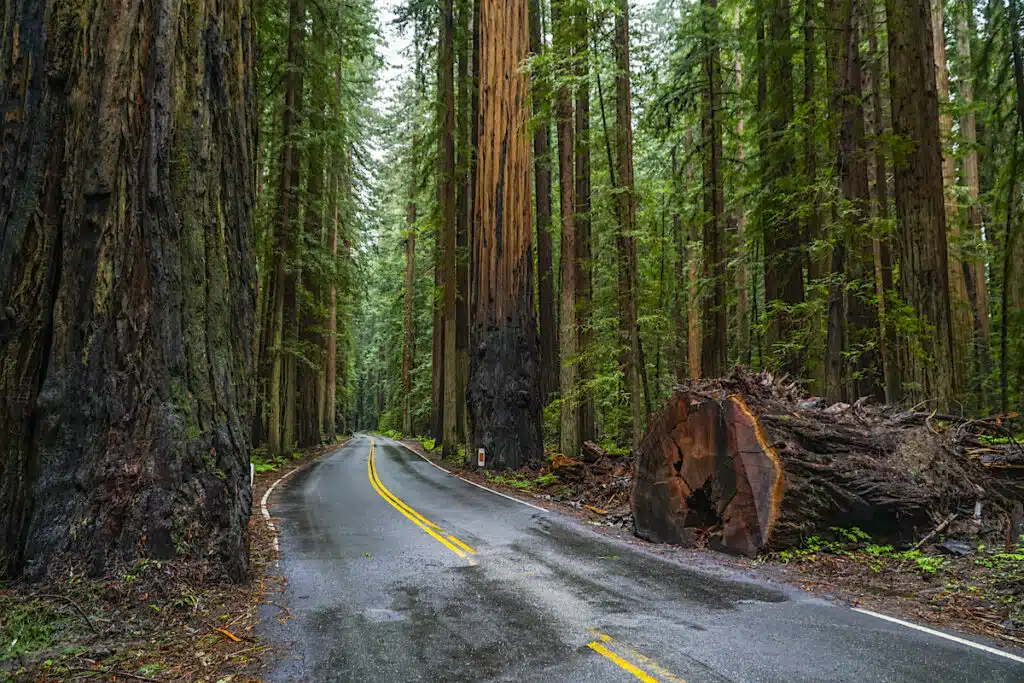
The park is divided into four major areas, each offering unique experiences. In the north, visitors can explore the Jedediah Smith Redwoods State Park, which is home to some of the largest and oldest trees in the park. The Prairie Creek Redwoods State Park, located in the center of the park, is another must-see area, with miles of scenic trails and the stunning Fern Canyon. Meanwhile, the south of the park is home to the Humboldt Lagoons, where visitors can enjoy kayaking and birdwatching. Finally, the Del Norte Coast State Park, located on the coast, is an excellent spot for hiking and camping, with picturesque views of the Pacific Ocean.
Things To See in Redwood National Park
The Redwood National Park is not only a place of natural beauty but also an essential ecosystem for wildlife. The park is home to over 200 species of birds and 40 species of mammals, including black bears, mountain lions, and Roosevelt elk. In addition, the park is a vital habitat for the endangered marbled murrelet, a seabird that nests in the park’s ancient redwoods.
Camping in Redwood National Park
The park has several campgrounds that provide tent and RV camping, including the Jedediah Smith, Del Norte Coast, and Gold Bluffs Beach campgrounds. Additionally, there are several lodges and hotels located just outside the park, such as the Hiouchi Hamlet, Elk Meadow Cabins, and the Redwood National Park Hostel. Camping considerations in Redwood National park include:
- Reservations recommended
- No hammocks can be attached to the trees
- RVers should confirm size of sites
- No laundry faciliteis
- No camp store
- Dump station available year-round
- No internet connectivity
- Cell phone service available
3. Rocky Mountain National Park
Rocky Mountain National Park, located in north-central Colorado, is one of the most popular national parks in the United States. Spanning over 415 square miles, the park is home to over 60 peaks reaching elevations of over 12,000 feet, including the famous Longs Peak, which towers at 14,259 feet. The park is also known for its vast wilderness areas, pristine alpine lakes, and diverse ecosystems, which are home to a wide range of flora and fauna, including elk, bighorn sheep, and mountain lions.
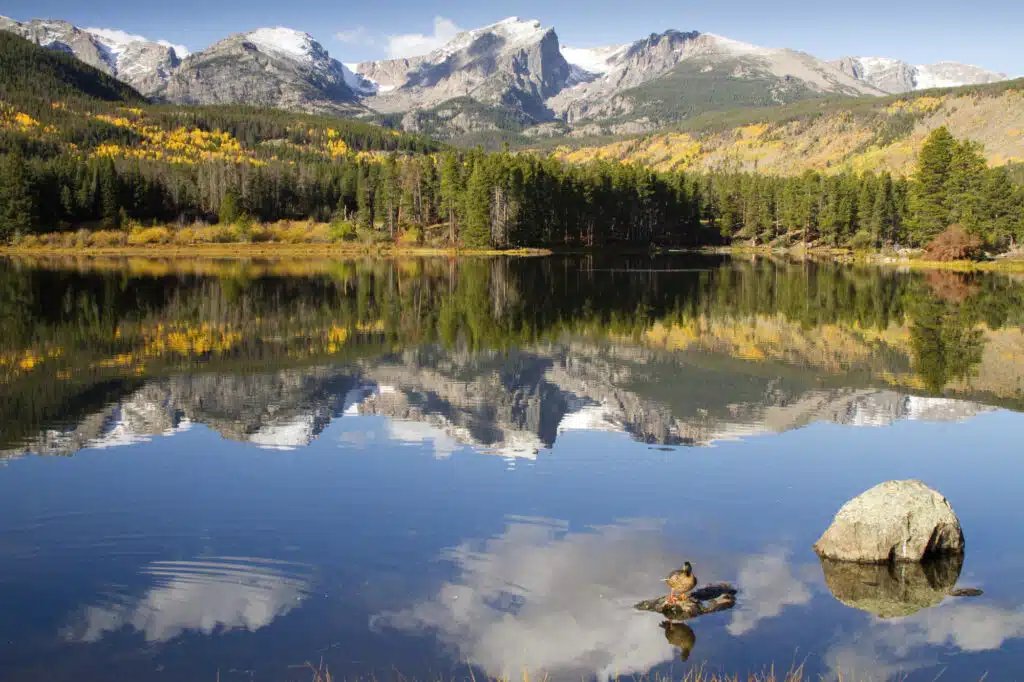
Things To See in Rocky Mountain National Park
One of the park’s most popular features is Trail Ridge Road, a 48-mile scenic drive that winds through the heart of the park, offering breathtaking views of the surrounding mountains and valleys. Visitors can also explore the park’s many hiking trails, ranging from easy strolls to strenuous backcountry treks. Some of the most popular hikes include the Emerald Lake Trail, the Bear Lake Trail, and the Chasm Lake Trail, each offering unique vistas of the park’s stunning landscapes.
In addition to its natural wonders, Rocky Mountain National Park also offers a rich cultural history. Visitors can explore historic sites such as the Holzwarth Historic Site, a 1920s dude ranch that offers a glimpse into the park’s early tourism industry, and the Fall River Visitor Center, which provides information about the park’s geology, ecology, and human history.
Campgrounds in Rocky Mountain National Park
Rocky Mountain National Park offers a variety of accommodation options, including campgrounds and lodges/hotels. There are five established campgrounds in the park, which offer different amenities and facilities. Moraine Park, Glacier Basin, and Aspenglen campgrounds offer reservations, while Longs Peak and Timber Creek campgrounds are first-come, first-served.
Additionally, the park has several lodges and hotels just outside it entries including the historic Stanley Hotel and the modern Estes Park Cabins. Visitors should note that peak season (June-September) can be busy, and reservations are recommended for all accommodation options. Other features include:
- Starting June 1, 2023 all entry and campground fees are cashless only
- If you have a camping reservation no timed entry permit required
- Moraine Park Campground is closed until 2024
- No laundry facilites
- Seasonal dump station available at Glacier Basin, Moraine Park, and Timber Creek campgrounds
- No electrical hook-ups available
- Seasonal potable water available at Glacier Basin, Moraine Park, Aspenglen and Timber Creek campgrounds
2. Yellowstone National Park
Yellowstone National Park is one of the most visited national park in the United States, covering an area of 2.2 million acres across Wyoming, Montana, and Idaho. The park is home to a diverse range of wildlife, including grizzly bears, wolves, bison, elk, and moose, and features unique geological formations, such as geysers, hot springs, and mud pots. Yellowstone was established in 1872, making it the first national park in the world and a symbol of America’s commitment to preserving its natural wonders for future generations.
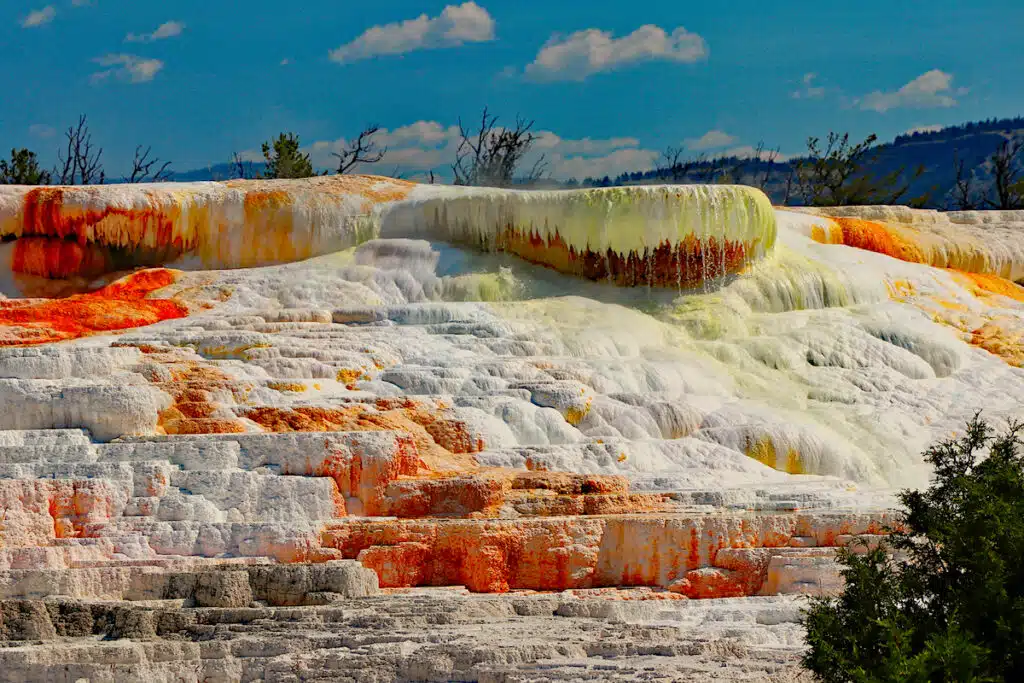
Things To See in Yellowstone National Park
One of the most popular features of Yellowstone National Park is its geothermal activity, which includes over 10,000 geothermal features, including Old Faithful, the park’s most famous geyser. Visitors can also explore the park’s numerous hot springs and mud pots, including the colorful Grand Prismatic Spring and the aptly named Mud Volcano. Yellowstone’s geothermal features are caused by the park’s location atop the Yellowstone Caldera, one of the largest volcanic systems in the world.
In addition to its geothermal features, Yellowstone National Park offers visitors a range of activities and attractions, including hiking, camping, fishing, and wildlife watching. The park is home to over 900 miles of hiking trails, ranging from easy strolls to challenging backcountry routes. Visitors can also enjoy guided tours, ranger-led programs, and educational exhibits at the park’s visitor centers. Other popular attractions include the Grand Canyon of the Yellowstone – best seen from Artist Point -, a dramatic gorge carved by the Yellowstone River, and the Lamar Valley, a prime location for spotting wildlife such as wolves, bears, and bison.
Campgrounds in Yellowstone National Park
Yellowstone National Park offers a variety of accommodation options for visitors, ranging from campgrounds to lodges and hotels. There are 12 campgrounds within the park, with over 2,000 individual campsites available for tents, RVs, and trailers. Each campground has its own unique features and amenities, including fire pits, picnic tables, and access to potable water and restrooms. Campground amenities also include:
- No delivered or pick up of rental RVs is permitted
- Fishing Bridge RV Park is only RV location with full hook-ups (50 Amp electrical)
- Dump stations available (seasonal depending on weather conditions)
- Laundry facilities available at Canyon, Fishing Bridge, and Grant Village campgrounds
- Cell phone available seasonally only at Mammoth, Grant Village, Fishing Bridge, Canyon, and Bridge Bay campgrounds.
In addition to camping, there are several lodges and hotels located throughout the park. These range from historic lodges like the Old Faithful Inn to modern hotels like the Lake Yellowstone Hotel. Each offers a different experience, with amenities such as restaurants, gift shops, and guided tours.
1. Yosemite National Park
Yosemite National Park, located in the Sierra Nevada mountains of California, is a breathtaking natural wonder that attracts millions of visitors every year. The park covers an area of over 1,200 square miles and is home to some of the most iconic natural landmarks in the United States. Yosemite Valley, a deep glacial valley surrounded by granite cliffs and waterfalls, is the park’s main attraction and draws visitors from all over the world.
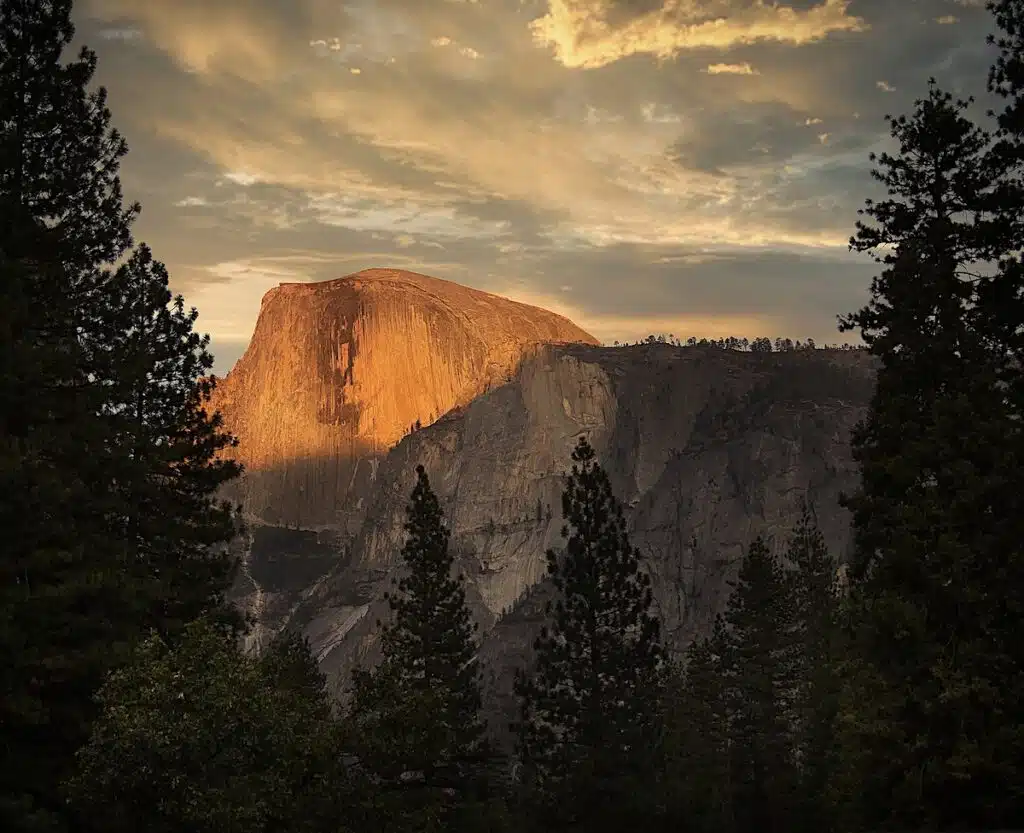
Things To See in Yosemite National Park
Yosemite National Park offers visitors a wide variety of outdoor activities and natural wonders to explore. Hiking and rock climbing are two of the most popular activities in the park, with many trails and climbing routes available for all skill levels. Yosemite Falls, one of the tallest waterfalls in the world, is another must-see attraction in the park. Other popular features include the granite monoliths Half Dome and El Capitan, as well as the giant sequoia trees found in the Mariposa Grove.
There are several locations within Yosemite National Park that visitors can explore, each offering its own unique experience. In addition to Yosemite Valley, visitors can also explore Tuolumne Meadows, a high-elevation meadow area surrounded by granite peaks and alpine lakes. Glacier Point offers stunning panoramic views of the park and is a popular spot for watching sunrises and sunsets. The Hetch Hetchy Valley, located in the northwestern part of the park, offers a more remote and peaceful experience, with fewer crowds and stunning views of the surrounding wilderness.
Campgrounds in Yosemite National Park
The park has 13 campgrounds that are spread throughout the valley, and reservations are highly recommended during peak season. The campgrounds offer various amenities, including fire pits, picnic tables, and restrooms. Notable campground features include:
- Campfires only allowed in fire rings and from 5 pm to 10 pm
- Reservations suggested for RV campgrounds
- No site hook-ups available at RV campgrounds (dump station and potable water station provided)
- Max RV length is 40 feet, maximum travel trailer/fifth wheel length is 35 feet (limited sites available)
- Reserving camping sites ahead of time: allowed pre-booking time varies by campground
- Max 6 people per campsite
- Quite hours: 10 am to 6 pm
- Generator use hours: 7 am to 9 am, noon to 2 pm, and 5 pm to 7 pm
- hammocks, clotheslines, and other tensioned lines are permitted
In addition to camping, Yosemite also has several lodges and hotels, including the luxurious Ahwahnee Hotel and the rustic Yosemite Valley Lodge. It’s important to note that lodging and camping in the park is very popular. Reservations should be made well in advance to secure availability.
